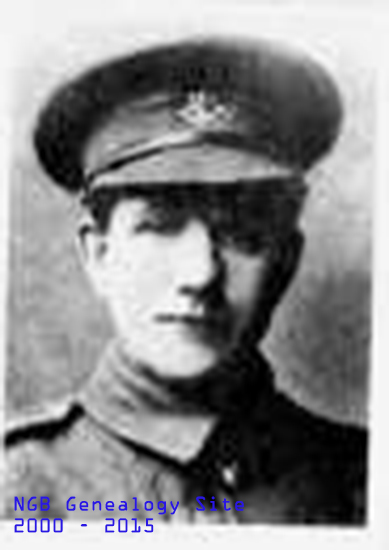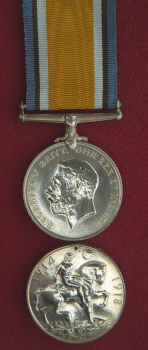Presented by the
Newfoundland's Grand Banks Site
to assist you in researching your Family History
Click on the graphic below to return to the NGB Home Page
To contribute to this site, see above menu item "About".
These transcriptions may contain human errors.
As always, confirm these, as you would any other source material.
| One Of The Original 500 |

Pte. William Roost
 William Roost, Regimental #76, Royal Newfoundland Regiment, was killed in action at Sailly-Saillisel, France, on March 2,
1917, during the Somme offensive . He was 24 years old, one of hundreds of young men from this regiment killed or wounded
on the battlefields of France during the Great War. William had barely survived the Battle of Beaumont Hamel the year
before - he was wounded in the right shoulder and had to be transported back to England to recuperate. He would return to
the war a few months later, early in 1917.
William Roost, Regimental #76, Royal Newfoundland Regiment, was killed in action at Sailly-Saillisel, France, on March 2,
1917, during the Somme offensive . He was 24 years old, one of hundreds of young men from this regiment killed or wounded
on the battlefields of France during the Great War. William had barely survived the Battle of Beaumont Hamel the year
before - he was wounded in the right shoulder and had to be transported back to England to recuperate. He would return to
the war a few months later, early in 1917.My interest in William Roost goes back to my grandmother's boarding house in downtown St. John's in the 1940s. My father discovered one of his war medals there, an inscribed British War Medal, unearthed in a small metal box. The rim of the medal bore an engraved identification: 76 Pte. William Roost. R. Nfld R. It had obviously been left behind from someone's personal effects, possibly those of a boarder who had since passed away. As I recall, my father was never quite sure of the details of where it had come from nor exactly how long it had been there, tucked away in an upstairs closet as it was. What we did know was that the British War Medal was special in a way - struck to commemorate only those who had taken part in the bloodiest battles ever fought by British and Commonwealth troops. In any case, he took possession of the medal, and upon his passing in 1989 gave it to me in safekeeping for this soldier of whom we knew so little. Unusual Name A great part of the mystery surrounding the medal all these years lay in the family name itself. Roost is uncommon, to say the least - certainly I'd never heard of it - and most people I asked hadn't heard of it either. It seems to have been equally unfamiliar to the people living at my grandmother's, as no one there could offer help of any kind. The owner certainly never spoke of the medal, perhaps out of fear it might become lost or stolen, given the difficult living conditions in a boarding house setting. I discovered, however, the name "Roost" had at one time been identified with a farming family in Mundy Pond, but I was unable to find anyone still connected to them or who could tell me what might have become of them. People from the area remember the name and confirm that there was a family by that name living there at one time but could offer little else. The name and the family to which it belonged, it seems, had died away - even back then - and taken with them the story of this young soldier and how his medal came to be in our possession. I discovered the connection to the deceased boarder just recently, and only now has the mystery of the man and his medal become clear. Little did I realize the ease with which I would be able to acquire his war records. Thanks to information given to me by Daniel Breen of the Newfoundland Grand Banks Genealogical Site and the availability of these records from Library and Archives Canada, it was only a matter of weeks before the full documented history of William Roost was on my desk. It turned out the boarder was indeed William's uncle, Patrick 'Paddy' Knox. I remember Paddy very well, a small pleasant man, one of several old men living out their lives in the sparse circumstances offered them at the time. Another was Peter 'Petey' Quirk, of Mobile, listed elsewhere in the Regiment's records as regiment # 5748. 'Petey' had been one of the lucky ones and survived the war. He was discharged in December, 1918. It seems likely now that when William's mother, Bridget Knox, passed away she gave the medal to Paddy Knox in remembrance of her son. Knox never revealed its existence and passed away leaving William's medal for others to discover and, hopefully, safeguard. Luck would have it that it fell into the hands of another veteran, in the person of my father, Nicholas Rossiter.Provided Background Ironically, William's war records reveal a great deal more insight and information than what I had been able to gather elsewhere. William had worked as a painter in St. John's, earning the grand sum of $7.20 per week. He lived with his mother and stepfather at 26 James Street and is described as being of fair complexion, with sandy hair and blue eyes. Like so many others of the day, he was of average height, about 5' 7". It is interesting to note that no sooner had he enlisted on October 1, 1914, than he was shipped off to England three days later, on the S.S. Florizel. From here the story of William Roost becomes integrated with that of the regiment itself: the arrival in England on October 15,1914, followed by months of strenuous military training in England and Scotland until embarkation for Egypt and Gallipoli at the end of August, 1915. The stay in Gallipoli lasted until the following March, 1916, when the regiment was ordered to join the British Expeditionary Force in France. In the lulls between embarkation and military training, William's personal record shows a healthy regard for life in general, and some rather enthusiastic diversions from the routine of life in the military. One can only imagine the intensity and level of camaraderie that went on around these young Newfoundland men so far from home and about to face the nightmare of war. There were occasional overnight forays away from camp, and missed parade drills here and there, together with notable but infrequent bouts of drinking. Interestingly though, such incidents occurred for the most part after the events at Beaumont Hamel.A Lonely Mother Among the documents I happened upon in this story of William Roost is a very moving letter from his mother to a commanding officer, a modest attempt to bring him home after his release from hospital in London. He had been gone from home a little more than two years and an anxious mother decided she would appeal to authorities to grant him furlough, and more than that - a period of rest at home. Her letter speaks for itself: November 2, 19164, Barter's Hill. To: Capt. Timewell, c/o Pay & Record Office. Dear Sir, I sincerely trust you will excuse me for troubling you but I want to know if it would be so good as to use your influence in getting my son William Roost, No. 76 of the 1st Newfoundland Regiment. He went across to England with the 1st 500 men and has not had a furlough since. I am sorry to trouble you, but my health of late is not the best and I would so much like to see him just once again. You will ever have my gratitude if you would just try and grant my request: I feel I am intruding too much on your valuable time, but you know it's only the request of a mother to see her child. Again thanking you in anticipation, I am earnestly, (Sd.) Bridget Knox. (Mother of No. 76, William Roost). In reply, Bridget Knox was told her request will be taken up "as may be consistent with all the circumstances" and that further communication should be made to the Regiment's headquarters in St. John's. No further correspondence was recorded on the matter. The request was obviously denied. A Glimpse Into Hell The combat in which William Roost's battalion was engaged near Sailly-Saillisel was an extension of the famous Battle of the Somme (1 July - 13 November, 1916.) and would continue to the end of the war. After his discharge from a British hospital at the end of July, 1916, William was granted a brief furlough and thereafter rejoined the British Expeditionary Forces in France at the beginning of February, 1917. I came across an item describing conditions at the Front which he would have faced upon his return, conditions so extreme as to collapse"... trenches, dumps, overhead shelters, and duckboards several furlongs at a time". The weather throughout February and March that year alternated between snows and heavy frosts to sudden, spring-like thaws which often grounded man and machine in five feet of mud. Novelist Rudyard Kipling, whose son was killed in this war, provides an extensive account of this period at the Somme, and in the following passage describes conditions and circumstances on February 1, 1917, the very day of William's return to the Front:
On the 1st of February (1917) in cold bright weather with
March 13, 1917. He had served 2 years, 143 days. On September 23, 1921, Bridget Knox received the Memorial Plaque, issued in respect of services of her son. On September 27, 1921, Bridget Knox received the Victory Medal and British War Medal in respect of services of her son. William Roost is buried alongside six of his fellow comrades from The Royal Newfoundland Regiment at the Sailly-Saillisel British Cemetery, Somme. You often see at war memorials, how people lean forward to run their fingers along the letters of the names engraved there. William's medal had that effect. My family frequently spoke of William Roost and wondered who he might have been. We displayed the medal at family gatherings several times each year, particularly on the anniversaries of the war. It stood as a symbol of all these young men, of those Newfoundlanders who fought at Beaumont Hamel, a reminder that their sacrifice and that of their comrades who did not return should never be forgotten. |
Return to the Contributed Records
Return to the Main Military Records Index
Military Records Contact: Sherwin Flight
Newfoundland's Grand Banks is a non-profit endeavor.
No part of this project may be reproduced in any form
for any purpose other than personal use.
JavaScript DHTML Menu Powered by Milonic
© Newfoundland's Grand Banks (1999-2025)
Hosted by
![]()
Your Community, Online!
![[Recent]](../../recent.gif)
![[Home]](../../home.gif)